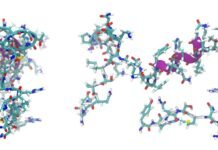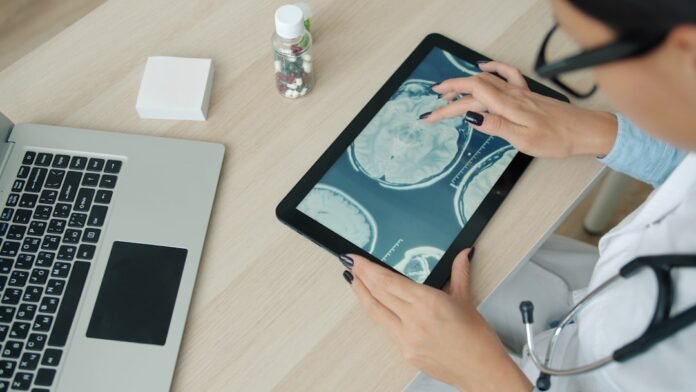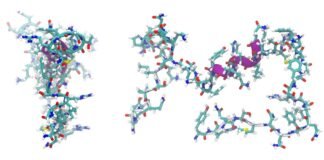The world of medicine is changing fast. New medical technologies and innovative supplies are changing how we deliver and receive care. These advancements are leading to better health for everyone.
At its core, innovation in healthcare means finding ways to provide “more for less.” We aim for better outcomes, greater convenience, and easier access, all while reducing costs and complexity. This focus helps expand what is possible in patient care.
The recent global pandemic greatly sped up this shift. It pushed healthcare into a new digital era. Today, the health tech sector is a huge industry, valued at over $154 billion in 2022. Experts predict it will continue to grow rapidly. This growth is driven by things like value-based care and patients wanting more tech-driven solutions.
We will explore the most important medical technology innovations. We will look at how digital tools, artificial intelligence, groundbreaking therapies, and safety improvements are reshaping patient care. An infographic later in this piece will show the top five areas of medical tech innovation we are excited about.

The digital change of healthcare is fundamentally altering how patients interact with the medical system and how care is delivered. From virtual consultations to continuous monitoring, technology is making healthcare more accessible, personalized, and efficient. This shift is driven by the increasing sophistication of digital tools and a growing demand for more convenient and patient-centric services. We are seeing a move towards a healthcare model where information flows seamlessly, empowering both patients and providers.
Reshaping Care Delivery with Telehealth
Telemedicine has emerged as a cornerstone of this digital revolution, experiencing a dramatic uptake in adoption, particularly accelerated by the recent global pandemic. The global telemedicine market, valued at USD 85.5 billion in 2022, is projected to expand at a compound annual growth rate (CAGR) of 24.3% from 2023 to 2030. This growth reflects its profound impact on patient care delivery.
Telehealth platforms enable virtual consultations, allowing patients to connect with healthcare professionals from the comfort of their homes. This significantly improves access to care, especially for individuals in remote areas, those with mobility issues, or those needing specialized care not readily available locally. Beyond convenience, studies show high patient satisfaction with telemedicine services, often due to reduced travel time, lower costs, and increased flexibility. It has proven invaluable for managing chronic conditions, providing mental health support, and offering timely medical advice, ensuring continuity of care that might otherwise be interrupted. For a deeper understanding of how these innovations are shaping the provision of essential medical equipment, exploring resources on ProMed DME medical innovations can provide valuable insights into the broader ecosystem of patient care.
Wearable Devices and Continuous Health Monitoring
Beyond episodic virtual visits, wearable devices are revolutionizing continuous health monitoring. The global wearable technology market was valued at USD 116.20 billion in 2022 and is projected to grow at a CAGR of 13.0% from 2023 to 2030, highlighting their increasing integration into daily health management. These devices, ranging from smartwatches to specialized patches, collect real-time data on various physiological parameters.
This constant stream of data, including heart rate, activity levels, sleep patterns, and even glucose levels, empowers individuals to take a more active role in managing their health. For physicians, this means proactive alerts for potential issues, allowing for timely interventions and personalized care adjustments. For instance, a sudden change in heart rhythm detected by a wearable could prompt an early consultation, potentially preventing a more serious cardiac event. This continuous monitoring is particularly beneficial for chronic disease management, enabling healthcare providers to track trends and respond to deviations before they escalate.
AI and Data-Driven Medicine
Artificial Intelligence (AI) and the vast amounts of data it processes are fundamentally changing the medical landscape. The AI in healthcare market is expected to reach USD 187.95 billion by 2030, growing at an impressive CAGR of 37.3% from 2023 to 2030. This growth underscores AI’s immense potential to revolutionize diagnostics, personalize treatments, and optimize healthcare operations. By leveraging big data analytics and sophisticated machine learning algorithms, AI can uncover patterns and insights that human analysis alone might miss, leading to more precise and effective medical interventions.
The Future of Diagnostics: AI-Powered Medical Technology Innovations
AI is rapidly becoming an indispensable tool in medical diagnostics, enhancing accuracy and efficiency across various specialties. In radiology, AI algorithms can analyze medical images like X-rays, MRIs, and CT scans with remarkable speed and precision, often identifying subtle abnormalities that might escape the human eye. Deep learning models are also proving invaluable in pathology, assisting in the analysis of tissue samples for cancer detection and classification.
Specific applications include the detection of diabetic retinopathy from retinal fundus photographs and the classification of skin cancer with dermatologist-level accuracy. These AI-powered tools reduce diagnostic errors, accelerate the diagnostic process, and free up clinicians to focus on complex cases and patient interaction.

Enhancing Treatment and Hospital Operations
Beyond diagnostics, AI is making significant strides in enhancing treatment strategies and streamlining hospital operations. AI algorithms can analyze a patient’s unique genetic profile, medical history, and lifestyle data to develop highly personalized treatment plans, optimizing drug dosages and therapeutic approaches. In hospital settings, AI-powered robotics are increasingly assisting in surgical procedures, offering greater precision and reducing recovery times. These robots also play a role in logistics, managing inventory, and even performing automated cleaning tasks, which contributes to a safer and more efficient environment.
The analysis of Electronic Health Records (EHR) data by AI tools allows for predictive analytics, identifying patients at high risk for certain conditions or adverse events, enabling proactive care. Furthermore, AI helps streamline administrative tasks, reducing the burden on healthcare staff and allowing them to dedicate more time to patient care. Pioneering efforts in this area, such as those demonstrated by IBM Watson Health, showcase how AI can integrate clinical, research, and social data to advance healthcare delivery and decision-making.
Groundbreaking Therapeutic and Surgical Medical Technology Innovations
The field of therapeutic and surgical innovations is experiencing an unprecedented surge in advancements, offering new hope for conditions once deemed untreatable. These breakthroughs are not only redefining treatment paradigms but also pushing the boundaries of what is medically possible. We are witnessing the rise of highly targeted therapies, personalized interventions, and solutions that aim to repair or even replace damaged biological structures. The global market for 3D printing in healthcare, for instance, is expected to reach USD 6.5 billion by 2030, growing at a CAGR of 16.1% from 2023 to 2030, underscoring the rapid evolution in this sector.
Personalized Treatments: Cellular and Genetic Medical Technology Innovations
The ability to manipulate cells and genes at a fundamental level has ushered in an era of highly personalized medicine.
- Gene Editing (CRISPR-Cas9): This technology allows for precise modifications to DNA, offering the potential to correct genetic mutations responsible for diseases like cystic fibrosis, sickle cell anemia, and Huntington’s disease. While still in early stages for many applications, CRISPR-Cas9 holds immense promise for curing genetic disorders at their source. Ethical considerations, particularly regarding germline editing, remain a crucial area of discussion and regulation.
- CAR T-cell Therapy: Chimeric Antigen Receptor (CAR) T-cell therapy is a groundbreaking form of immunotherapy for cancer. It involves genetically engineering a patient’s own T-cells to recognize and attack cancer cells. This highly effective treatment has shown remarkable success in certain types of leukemia and lymphoma, offering a new lifeline for patients who have exhausted other options.
- mRNA Vaccines and Therapies: The rapid development of mRNA vaccines for COVID-19 demonstrated the incredible potential of this technology. mRNA vaccines work by instructing cells to produce a harmless piece of a virus, triggering an immune response. This platform offers faster development times, lower production costs, and greater flexibility to adapt to new pathogens or even target cancer cells, paving the way for a new generation of vaccines and therapies.
The Rise of Regenerative and Bioprinted Solutions
Regenerative medicine focuses on repairing, replacing, or regenerating damaged tissues and organs, moving beyond traditional transplantation or prosthetics.
- Stem Cell Therapy: This involves using stem cells, which have the unique ability to develop into various cell types, to repair damaged tissues or treat diseases. Research is ongoing for conditions ranging from spinal cord injuries to heart disease, showing promising results in restoring function and promoting healing.
- 3D Bioprinting: This advanced technology uses specialized “bio-inks” containing living cells to create three-dimensional tissue structures. From printing skin grafts for burn victims to developing cartilage for joint repair, 3D bioprinting is changing reconstructive medicine. The ultimate goal is to bioprint entire functional organs, addressing the critical shortage of donor organs. This field relies heavily on the development of innovative medical materials that are biocompatible and can support cell growth and function. Our research into such advanced materials is crucial for pushing the boundaries of regenerative therapies.

Enhancing Safety and Training in Clinical Settings
Patient safety is paramount in healthcare, and technology is playing an increasingly vital role in reducing human error, enhancing precision, and providing advanced training. Innovations in virtual and augmented reality, coupled with robotic assistance, are creating more controlled and effective environments for both medical professionals and patients. These technologies are not just about efficiency; they are about minimizing risks and optimizing outcomes.
Creating Safer Healthcare Environments
Hospitals and clinics are complex environments where safety is a constant concern. Technology is stepping in to address challenges like hospital-acquired infections (HAIs) and data security.
- Infection Control: Advanced technologies are being deployed to combat HAIs. This includes smart facility management systems that monitor environmental conditions and automated cleaning robots that disinfect surfaces. A crucial aspect of this is the use of specialized disinfection methods. For instance, MicroLumix UVC disinfection technology offers a powerful tool to eliminate harmful pathogens from surfaces and air, significantly reducing the risk of infection transmission in healthcare settings.
- Data Security: With the increasing digitization of patient records and the rise of interconnected medical devices, cybersecurity is more critical than ever. Technologies like blockchain are being explored to create secure, immutable ledgers for patient data, protecting sensitive information from breaches and ensuring patient privacy.
The Role of Clinicians in Health Tech Integration
While technology drives innovation, the human element—particularly the expertise of physicians and other clinicians—remains indispensable. Healthcare professionals play a crucial role in the development and successful integration of health tech. Their deep understanding of clinical workflows, patient needs, and the practical realities of care delivery is vital for creating effective and user-friendly solutions.
Clinicians are instrumental in identifying unmet clinical needs, providing invaluable feedback during the iterative product development process, and validating the efficacy and safety of new technologies. Opportunities for healthcare professionals to get involved in the tech industry are expanding, from advisory roles to leading product development teams. Their active participation ensures that technological advancements genuinely improve patient outcomes and integrate seamlessly into clinical practice, rather than becoming isolated solutions.
Frequently Asked Questions about Medical Technology
As medical technology continues its rapid evolution, many questions arise about its impact, ethics, and future. Here, we address some of the most common inquiries.
What is the biggest innovation in medical technology recently?
While pinpointing a single “biggest” innovation is challenging due to the breadth of advancements, several stand out for their transformative potential:
- AI in Diagnostics: Revolutionizing the speed and accuracy of disease detection across specialties like radiology and pathology.
- mRNA Vaccine Platform: Demonstrated its power during the COVID-19 pandemic, offering rapid development and adaptability for various infectious diseases and even cancer.
- CRISPR Gene Editing: Providing unprecedented precision in modifying DNA, holding the promise of curing genetic disorders.
- Telehealth Expansion: Dramatically increasing access to care and reshaping patient-provider interactions, accelerated by the pandemic.
These innovations are not just incremental improvements; they represent fundamental shifts in how we approach diagnosis, treatment, and care delivery.
How is technology improving patient outcomes?
Technology is improving patient outcomes in numerous ways:
- Earlier and More Accurate Diagnosis: AI and advanced imaging lead to quicker and more precise identification of diseases.
- Personalized Treatments: Genetic sequencing and AI enable therapies custom to individual patient profiles, maximizing effectiveness and minimizing side effects.
- Better Chronic Disease Management: Wearable devices and remote monitoring allow for continuous tracking and proactive intervention, preventing complications.
- Increased Access to Care: Telemedicine breaks down geographical barriers, bringing healthcare to underserved populations.
- Empowering Patients with Data: Patients have more access to their health information, enabling them to make informed decisions and actively participate in their care.
Collectively, these advancements lead to more effective interventions, better disease prevention, and an overall improvement of patient well-being.
What are the ethical challenges of new medical technologies?
The rapid pace of medical technology innovation also brings significant ethical considerations:
- Data Privacy and Security: The vast collection and sharing of patient data raise concerns about who has access to sensitive information and how it is protected from breaches.
- Algorithmic Bias in AI: AI systems, if trained on biased data, can perpetuate or even amplify health disparities, leading to unequal care. Ensuring fairness and transparency in AI algorithms is crucial.
- Equitable Access and Cost: Many advanced therapies and technologies are expensive, raising questions about equitable access and whether they will widen the gap between those who can and cannot afford cutting-edge care.
- Genetic Editing Ethics: Technologies like CRISPR-Cas9 raise profound ethical questions, particularly regarding heritable changes to the human genome and the potential for “designer babies.”
- Patient Consent: As technologies become more complex, ensuring patients fully understand and provide informed consent for treatments involving AI, genetic modification, or extensive data collection becomes more challenging.
Addressing these ethical challenges requires ongoing dialogue, robust regulatory frameworks, and a commitment to patient-centered values.
Conclusion: The Future of Health is Here
The journey through medical technology innovations reveals a landscape of profound change. From the digital convenience of telehealth and wearable devices to the analytical power of AI, and the groundbreaking precision of gene editing and regenerative therapies, we are witnessing a fundamental reshaping of healthcare. These advancements promise not only to extend lives but also to dramatically improve their quality.
The impact on patient outcomes and healthcare delivery is undeniable: earlier diagnoses, more personalized treatments, improved safety, and greater accessibility. Yet, as we accept these technological marvels, we must also remember the irreplaceable value of the human touch in healthcare. Technology serves as a powerful enabler, but it is the compassionate, informed care of clinicians that ultimately defines the patient experience.
Looking ahead, the future outlook for medical science innovations is one of continued acceleration. We anticipate even more sophisticated AI applications, further breakthroughs in cellular and genetic therapies, and increasingly integrated digital health ecosystems. To steer this exciting future responsibly, collaboration between clinicians, technologists, policymakers, and patients will be paramount. By working together, we can ensure that these innovations are developed and applied ethically, equitably, and effectively, truly making the future of health better for all. This collaborative spirit is what drives the continued evolution of SemiCera Medical Innovations and similar pioneering efforts across the industry.
























